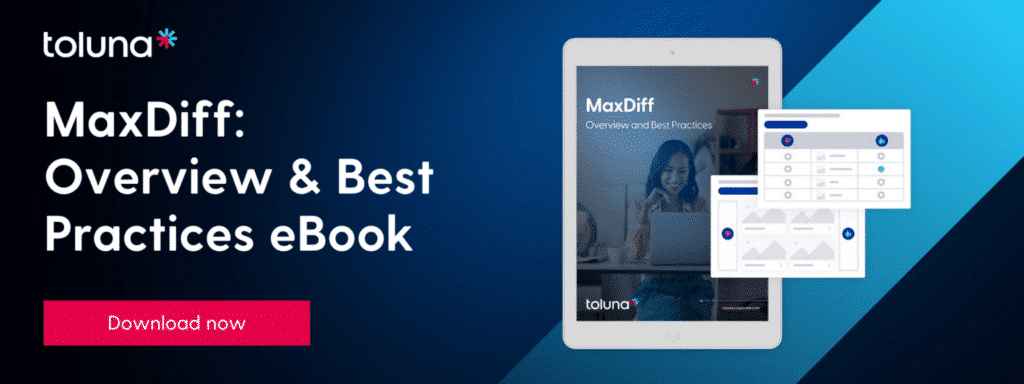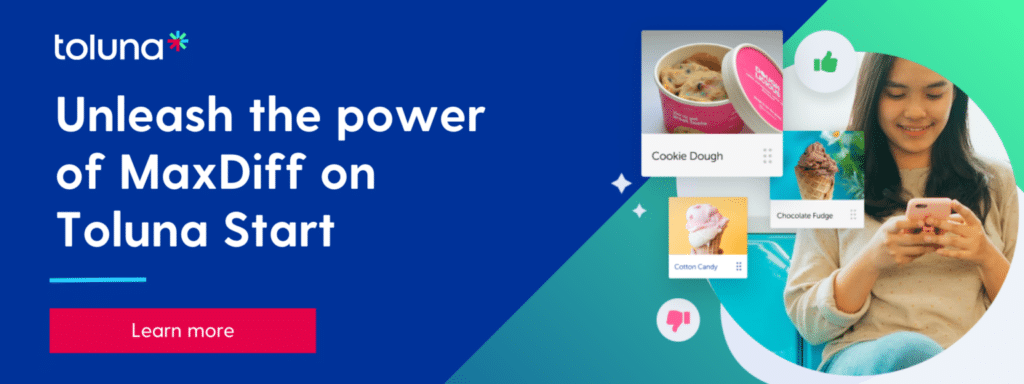MaxDiff, which is short for Maximum Difference Scaling, is a technique used to measure the relative preferences or importance of different items. It is also known as best-worst scaling (“BWS”) or maximum differentiation.
BWS was developed by Jordan Louviere in the late ‘80s to deal with long lists of items, specifically in instances when it wouldn’t make sense for a respondent to rank all the items in the list.
For example, let’s say you want to decide on a name for the brand you are rolling out. You have a list of 25 names and want to understand what name consumers like most and least. You don’t want to ask consumers to rank 25 names, as this would lead to poor data quality and unreliable results. Instead, you can use MaxDiff, where respondents are presented with a set of names and are asked to indicate the best and worst options from each subset.
By systematically presenting different subsets of names to respondents and analyzing their choices, you can derive a rank order or score for each name based on the frequency with which it is chosen as the best or worst. The result gives a clear answer to consumer preferences without having to directly ask.
Overall, MaxDiff is a powerful technique for quantifying and comparing preferences in a way that goes beyond simple ratings or rankings.
What are the key elements of a MaxDiff research design?
1. Question type: A specific question type and format are used to allow respondents to make best-worst comparisons and enter responses.
2. Experimental design: The comparisons that respondents are asked to make differ depending on which subsets and order are assigned by the design algorithm.
3. Data analysis: Can vary from standard to more advanced analysis methods.

What are the benefits of using MaxDiff?
1. Measurement of relative importance
MaxDiff enables the measurement of relative importance or preference among a set of items. It allows respondents to make choices based on the maximum difference between the most and least preferred options. This provides more discriminatory power than simple rating scales or rankings.
2. Reduction of response biases
MaxDiff helps reduce response biases that can be present in other rating or ranking methods. By forcing respondents to make trade-offs and choose the best and worst options, it minimizes the tendency to give extreme or identical ratings to all items.
3. Reduced mental effort for the respondent
We, as humans, are better at evaluating things at their extreme, meaning we can more easily say which thing we prefer the most/least from a given list of items, while we might find it more difficult to “rank” those in the middle. For this reason, MaxDiff only focuses on the most/least preferred items. By collecting this information from respondents through several scenarios, it determines the overall “order,” even though no respondent has been exposed to the full list at once.
4. Robustness to scale use heterogeneity
MaxDiff accommodates variations in respondents’ use of scales. People may have different interpretations of rating scales, which can lead to response inconsistencies. With MaxDiff, respondents are only required to make best-worst choices within each choice set, making it less susceptible to scale use heterogeneity.
5. Efficient survey design
MaxDiff allows researchers to collect rich data with a manageable number of questions. By presenting respondents with choice sets that include subsets of a list of items, researchers can gather comprehensive preference data without overwhelming respondents with an exhaustive list.
6. Clear interpretation and actionable insights
The results of MaxDiff analysis provide clear and interpretable outputs, such as preference scores or rankings for the items. This makes it easier for researchers to understand and communicate the findings, enabling data-driven decision-making and actionable insights.
7. Flexibility and applicability
MaxDiff can be applied to various research contexts. We find it most useful for claims, names, taglines, and variety tests.
Ready to unleash the power of MaxDiff with Toluna Start? Learn more about our solutions, check out case studies from leading global brands, and get in touch with our team through the link below.





